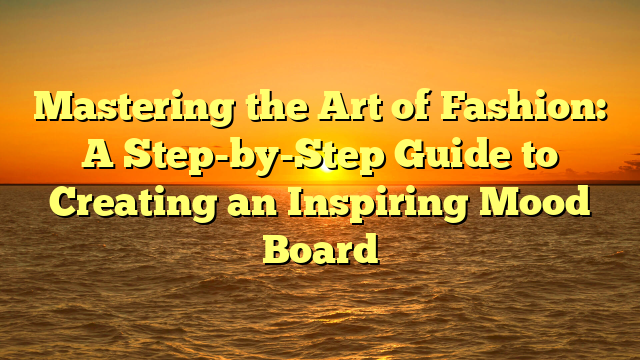Mastering the Art of Fashion: A Step-by-Step Guide to Creating an Inspiring Mood Board
Mastering the Art of Fashion: A Step-by-Step Guide to Creating an Inspiring Mood Board
Introduction
Fashion is an art form that requires creativity, passion, and a keen eye for detail. Whether you are a fashion designer, stylist, or simply someone who loves fashion, creating a mood board is an essential step in the design process. A mood board is a visual representation of your ideas, inspirations, and concepts. It helps you to organize your thoughts and communicate your vision to others. In this article, we will guide you through the process of creating an inspiring mood board that will help you to master the art of fashion.
Step 1: Define Your Concept
Before you start creating your mood board, you need to define your concept. What is the message you want to convey through your fashion design? Is it a particular theme, color scheme, or style? Once you have a clear idea of your concept, you can start gathering inspiration.
Brainstorming
Brainstorming is a great way to generate ideas and inspiration for your mood board. You can do this by creating a mind map or a list of keywords related to your concept. For example, if your concept is “Bohemian Chic,” you can brainstorm keywords such as “flowy fabrics,” “earthy tones,” “fringe,” and “layering.”
Research
Research is another important step in the process of creating a mood board. You can gather inspiration from various sources such as fashion magazines, blogs, social media, and even nature. Look for images, colors, textures, and patterns that resonate with your concept. You can also research the work of other fashion designers who have created similar designs.
Step 2: Collect Your Inspiration
Once you have defined your concept and gathered inspiration, it’s time to start collecting your images. You can do this by creating a physical or digital mood board.
Physical Mood Board
A physical mood board is a great way to get hands-on with your inspiration. You can use a corkboard or a foam board and pin or glue your images onto it. You can also add fabric swatches, trims, and other materials to create a tactile experience.
Digital Mood Board
A digital mood board is a more convenient option if you prefer to work on your computer. You can use software such as Canva, Adobe Photoshop, or even Pinterest to create your mood board. You can also use online resources such as Unsplash or Pexels to find high-quality images.
Step 3: Organize Your Images
Once you have collected your images, it’s time to organize them. You can do this by grouping them into categories such as color, texture, or style. This will help you to see the common themes and patterns in your inspiration.
Color
Color is an important element in fashion design. You can group your images by color to see which colors work well together and which ones don’t. You can also use color palettes to create a cohesive look.
Texture
Texture is another important element in fashion design. You can group your images by texture to see which textures work well together and which ones don’t. You can also use texture swatches to create a tactile experience.
Style
Style is the overall aesthetic of your fashion design. You can group your images by style to see which styles work well together and which ones don’t. You can also use style boards to create a cohesive look.
Step 4: Create Your Mood Board
Now that you have organized your images, it’s time to create your mood board. You can do this by arranging your images on your physical or digital board. You can also add text, quotes, or other elements to enhance your message.
Layout
The layout of your mood board is important. You can arrange your images in a grid, a collage, or a linear format. You can also use negative space to create a balanced look.
Text
Text is a great way to enhance your message. You can add quotes, keywords, or even your own notes to your mood board. You can also use typography to create a cohesive look.
Step 5: Use Your Mood Board
Now that you have created your mood board, it’s time to use it. You can use your mood board as a reference when designing your fashion collection. You can also use it to communicate your vision to others such as clients, stylists, or manufacturers.
Presentation
Presentation is important when using your mood board. You can present your mood board in a professional manner by using a portfolio or a digital presentation. You can also use your mood board as a visual aid during meetings or presentations.
Feedback
Feedback is important when using your mood board. You can ask for feedback from others to see if your message is clear and effective. You can also use feedback to improve your mood board and your fashion design.
Conclusion
Creating a mood board is an essential step in mastering the art of fashion. It helps you to organize your thoughts, communicate your vision, and create a cohesive look. By following these steps, you can create an inspiring mood board that will help you to design your fashion collection with confidence and creativity.

